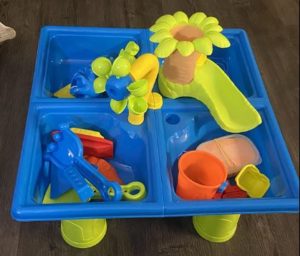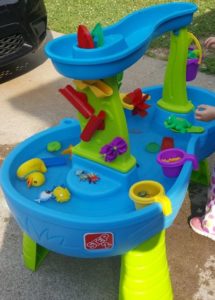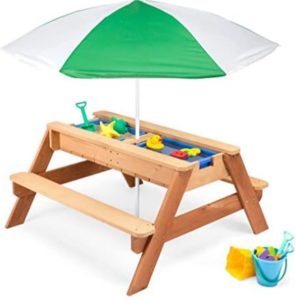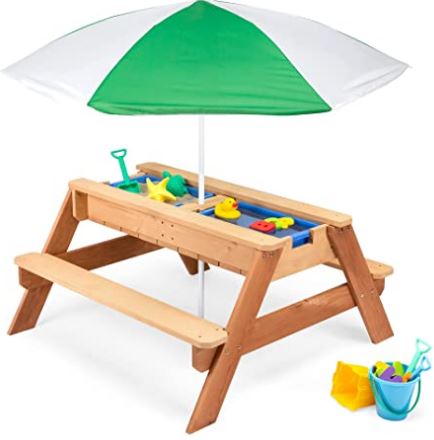Parents understand the importance of providing for their children. Providing for their needs includes their brain development. One of the most common ways to aid a child in expanding their mind is a sensory table! In this post we will be talking about a sensory table for 1 year old.
A sensory table is provided to children to develop their skills and understanding of the world. In other words, a sensory table makes new experiences accessible to children of all ages in a supervised setting.
Sensory tables can be incorporated in children as young as one year old! It is crucial to introduce sensory processing into your little one’s life. But how do you know which sensory table to buy, or can a sensory table be a DIY project?
Keep reading to learn about the importance of sensory tables and which one to choose!
What is a Sensory Table?
When looking for sensory table for 1 year old’s, a sensory table can refer to a container, a bucket, a table, etc. You can purchase manufactured sensory tables, but it’s the inside that makes a sensory table!
To make new experiences accessible, sensory tables often contain materials and items foreign to the child’s senses. It introduces new textures, smells, sights, sounds, and sometimes tastes.
Many parents and teachers choose to incorporate their own materials for their sensory tables. For others, it’s far easier to purchase a ready-made sensory table.
By incorporating new items, children will begin to explore and expand their knowledge.
Why Should You Use a Sensory Table?
There are countless benefits of introducing a sensory table into a child’s life. In addition to expanding their knowledge, you are aiding cognitive development with sensory tables.
When presenting items to stimulate their senses, you are contributing to their physical, emotional, and mental development.
Physical Development
With new textures to explore and items to play with, children can develop their fine motor skills and gross motor skills. They can practice picking up items, moving them, and rearranging them.
With practice, they will use their muscle memory when building and creating. This skill will eventually seep into everyday life. If they can practice in a controlled environment, their abilities will grow.
Emotional Development
Some new textures and sights may prove to be calming to a growing mind. Many researchers report that using a sensory table can teach a child calming skills. Sensory tables can contain soft, mesmerizing items.
For example, kinetic sand and soft items can be extremely soothing to handle. Children begin to understand the calming effects of these items as they spend more time with them.
Not only can it calm their mind, but it gives them an outlet to practice their social skills; especially when playing with other people. Children can learn about sharing, delegation, communication, and more.
Mental Development
A sensory table helps children understand and localize problems. With new items at their disposal, little ones will begin exploring and playing. Children that actively seek out these new experiences will logically experience small, child-like problems; problems such as maneuvering and building. The great thing about experiencing these problems is that they will develop problem-solving skills!
Another example of mental development is the development of pretend play, imagination, and creativity. With senses stimulated, children will begin to play, and their minds will continue to expand.
What Should Be in Your Sensory Table?
The things in a sensory table should address at least one of the following senses.
- Hearing
- Sight
- Smell
- Taste
- Touch
The purpose of a sensory table is to introduce new items for sensory processing. For hearing, parental figures can use jangly keys, maracas, music, etc. Items that are great for touching are as follows: cotton balls, rice, sand, water, beans, odd textures, etc. For sight, bright colors, unknown animals, and inviting shapes can help!
Before using tastes and smells, it is crucial to supervise and aid children in these exploration sessions.
Sensory Table for 1 Year Old’s
UNIH Kids Sensory Table
The UNIH Kids Sensory Table was originally created for the snow and children one to three years old. With this snow table, children can explore the snow in their own way. Many parents saw the potential which caused this to become an increasingly popular sensory table without the snow!
The UNIH Kids Sensory Table comes with 19 accessories that children can use as they are exploring. The following accessories are included:

- A Boat
- Beach Sand Table
- One Tree
- A Pinwheel
- Some Kinetic Sand
- 5 Beach Tools (sea creature molds, etc.)
- 9 Beach Toys Models and Tools (spade, shovel, trowel, boats, trains, cars, etc.)
According to UNIH, their Kids Sensory Table improves children’s hands-on abilities, grasping abilities, color perception, brain development, and allows physical exercise.
Step 2 Kids Water Play Table with 13-Piece Accessory Set
The Step 2 Kids Water Play Table with a 13-Piece Accessory Set is also a great sensory table for one-year-olds. This spacious water table is great for multiple children to play together; helpful while encouraging social skills. With each water play table, there are thirteen accessories and toys.

- One Large Bucket
- Two Mini Buckets
- Scooper
- Fish
- Frog
- Rubber Duck
- Sifter
- Three Open Rain Maze Pieces
- Spinners
- Boat
According to Step 2, their sensory table is perfect for sensory exploration, STEM learning, language + social skills, and physical + motor skills. The water sensory table is an excellent way to introduce textures, temperatures, sights, and sounds.
Best Choice Products Castle Sandbox 2 in 1 Sand and Water Table
 The Best Choice Castle Sandbox 2 in 1 Sand and Water Table is extremely versatile. There is a detachable play center for each sensory table. With the play center attached, children have access to castles, bridges, and a moat.
The Best Choice Castle Sandbox 2 in 1 Sand and Water Table is extremely versatile. There is a detachable play center for each sensory table. With the play center attached, children have access to castles, bridges, and a moat.
When the play center is not attached, there are two large buckets for parental figures to customize. Parents can incorporate their own sensory tools and items.
Each sensory table also comes with a shovel, rake, boat, and bucket; these items can be used with water, sand, or your own sensory tools!
In Conclusion
Finding a sensory table for a one-year-old doesn’t have to be complicated! There are many choices to choose from while shopping. And if you can not find a sensory table that matches your vision, create your own!
A sensory table is only a holder for much more exciting things. Children can be easily amused, and a sensory table is guaranteed to keep their attention and keep their brain growing!
Will you buy a sensory table for 1 year old, or will you make your own? Let us know what you decide!

